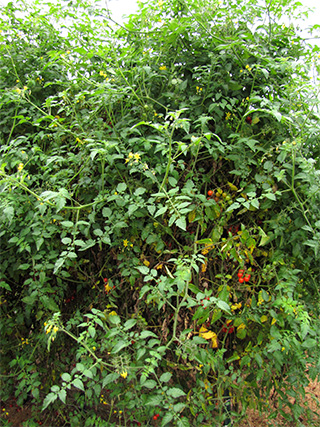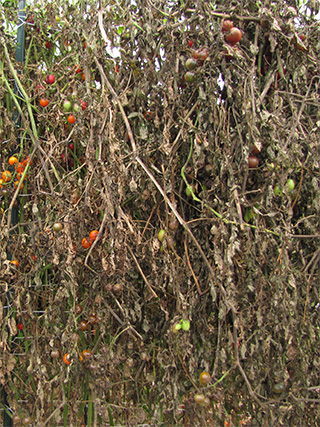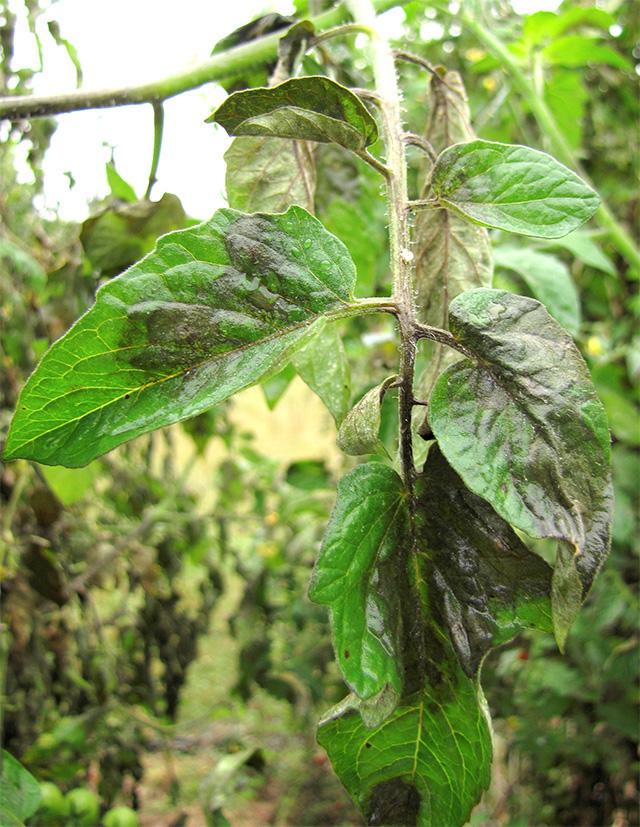From Margaret McGrath (mtm3@cornell.edu), reposted from CCE Suffolk Long Island Gardening (2016-06-06):


Late blight-resistant tomato variety Jasper (left) and susceptible SunGold (right) severely affected by late blight. Both images taken on 9 Oct 2013 in my garden. Click images for larger view.
Late blight is arguably the worst problem that can appear in a vegetable garden! Its highly contagious and very destructive nature means everyone growing susceptible tomato and potato plants – gardeners and farmers alike – needs to take action to prevent late blight from occurring and needs to respond quickly when it appears. The major epidemics of this disease on Long Island in 2009 and 2011 are thought to have started with just a few infected plants.
Early Season Action Steps to Prevent Late Blight:
- Select varieties that have resistance to late blight. For example, the popular SunGold cherry tomato is susceptible to it; Jasper cherry tomato is not. Find more information about resistant tomato varieties at the eXtension website.
- Plant certified potato seed. Do not plant potatoes from last year’s garden or from the grocery store. There is a higher probability for the late blight pathogen (Phytophthora infestans) to be in “table-stock” potatoes.
- Destroy any potato plants that grow as “volunteers” in compost piles or in the garden from potatoes not harvested last year.
- Inspect tomato seedlings carefully for symptoms before purchasing them. The pathogen as it exists in the United States is not known to survive in tomato “true” seed and then infect the seedlings, so if you grow your own seedlings, late blight is not a concern until they are planted. Seedlings become infected by growing near other affected plants.
- Become knowledgeable about the different symptoms of late blight and its imitators. I have posted more photographs of late blight on tomatoes and on potatoes.
- Monitor the occurrence of late blight in the United States at usablight.org. You can sign up on that website to get an alert by text or e-mail when a report has been logged nearby, so you can be one of the first to know when late blight has been found on Long Island.
- Inspect your tomato and potato plants for symptoms at least once weekly.

What to do when late blight symptoms are found:
Immediately call our Horticulture Diagnostic Lab at our hot line at 631-727-4126 from 9 a.m. to noon, Monday through Friday. Alice Raimondo and Sandra Vultaggio, our Horticulture Consultants, can help determine whether you do, indeed, have late blight, and answer questions about proper handling of an outbreak. (Elsewhere in New York, contact your local office of Cornell Cooperative Extension. Outside New York, find local contact here.)
Best management steps for dealing with disease are based on knowledge of the pathogen’s biology and life cycle. The late blight pathogen in the United States is not known to reproduce sexually, as it does elsewhere in the world including in parts of Europe. Where it does reproduce sexually, it produces a type of spore (oospore) that enables the pathogen to survive in true seed and in soil; consequently, rotation is an important management step in Europe, but this is not necessary for controlling late blight in the United States.


